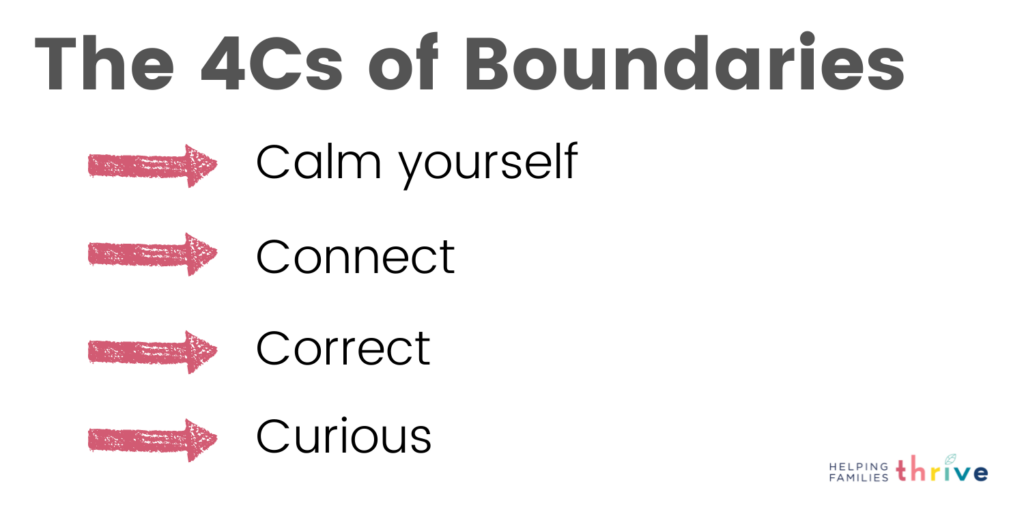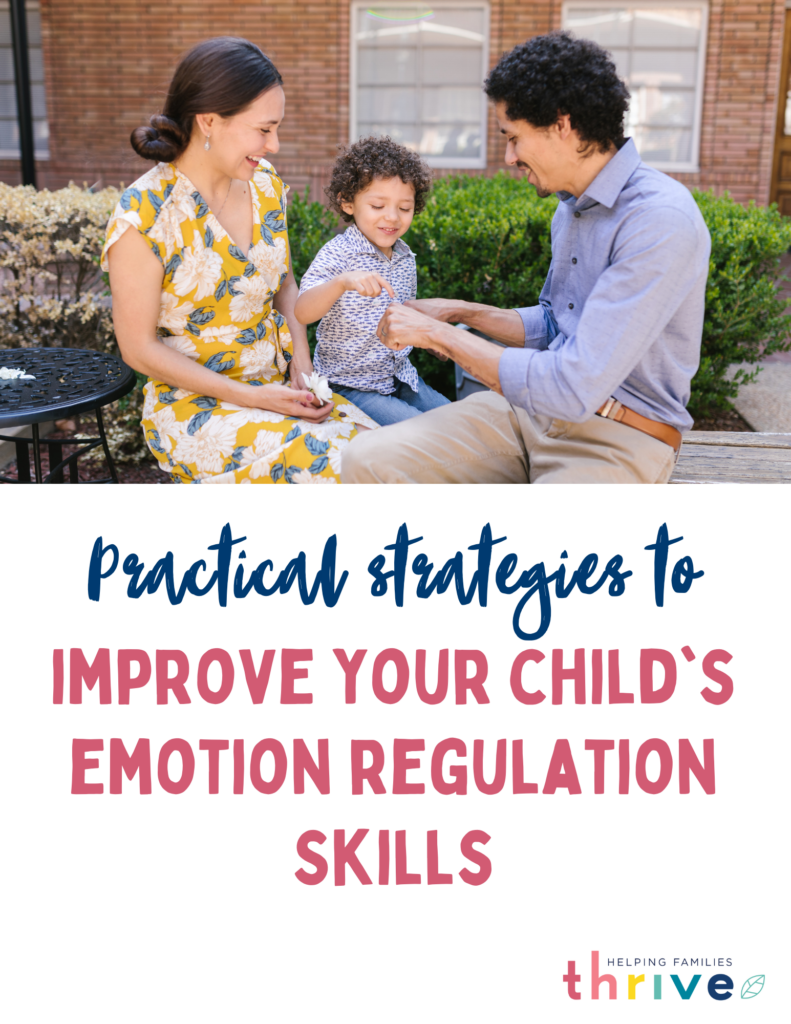
Have you ever asked yourself (or someone else) any of these questions:
- “What do I do when my toddler has a tantrum?”
- “How do I get my child to stop hitting their sibling?”
- “How can I get my child to stop whining?”
- “I need to stop the food throwing! How?”
- “How do I respond when my child refuses to do what I ask?”
While these questions are common, and in fact make a lot of sense, they are missing a really big part of the equation… prevention! Rather than focusing just on what to do once a challenging behavior occurs, it’s important to also learn strategies to help decrease the likelihood of these behaviors happening in the first place. This means we need both prevention and response strategies in our parenting toolbox.
The HFT Prevention & Response Framework

Let’s first explore why prevention is so critical. The most rigorously studied and effective parenting programs, such as The Incredible Years and Triple P, all start with prevention strategies. When parents come to us and ask, “What should I do when my child hits?” we don’t initially focus on what to do IN THAT MOMENT in RESPONSE to the behavior.
If we focus primarily on responses we end up relying on giving frequent corrections and consequences. Corrections and consequences can be useful tools as we’ve discussed before. However, research shows that when they are overused they are less effective. Additionally, behaviors can actually get worse when we fall into the correction cycle (see this post for more). Plus, if you spend your days correcting your child, parenting isn’t very fun!
To further understand the importance of prevention, we have to take a step back and look to the research. We can lump the parenting skills taught in the most researched evidence-based programs into two main categories. The first category are skills designed to increase warmth in the parent-child relationship and increase positive behaviors. The second category includes teaching parents how to set and hold effective boundaries. In our own e-Course, we conceptualize these evidence-based skills in the HFT parenting tree.

As you can see, the vast majority of the skills revolve around prevention strategies rather than response strategies. Prevention tools decrease the frequency of challenging behaviors, and when there are less challenging behaviors occurring both parents and children feel better. Additionally, parents tend to be more effective at responding to challenging behaviors when they aren’t happening all the time.
While prevention should be the bulk of the work in our parenting approach, the way we respond and set boundaries is equally important! There are helpful and unhelpful ways that parents respond to behaviors. For example, research shows that harsh punishment actually leads to more negative behavior — exactly what parents are trying to minimize. This is why we need BOTH effective prevention and response strategies in our parenting toolbox. Let’s take a look at a few key skills in each area.
Key Prevention Strategies
When it comes to emotion regulation and challenging behavior, the foundation of prevention is the emotional piggy bank. Imagine each child has an emotional piggy bank they carry around with them. Each time a child is noticed, affirmed, or given time or affection, we make a deposit into their piggy bank. Each time we place a demand (such as asking questions, issuing commands or consequences) or have a negative interaction (such as yelling) with our child, we make an emotional withdrawal.
Our goal is to avoid our child going into “emotional overdraft,” which is when more is coming out of the piggy bank than going in. When a child is in emotional overdraft, they have more difficulties with managing their emotions and behaviors. There are many tools that can help parents increase deposits and make wiser withdrawals, but here we are sharing a few of the most impactful:
Prevention Tip 1: Special Time
Special time, also known as child-directed play, is one of the most powerful ways to improve behavior and fill up the piggy bank.
Some of you may be thinking, “but I already play with my kid a lot!” This is different! This is 10 minutes of time dedicated to completely child-led play. You’ll likely be able to use some of the play you’re currently engaging in with your child and turn it into Special Time following these guidelines:
- Set aside 10-15 minutes of play each day with your child.
- Follow your child’s lead and avoid directing their play.
- Replace questions and commands with descriptions. Rather than saying “What does the cow say?” or “What are you doing there?” simply comment on what you see.
- Resist teaching and enforcing rules.
- Give it a name such as “mom and Sarah special time” to make it more impactful.
Prevention Tip 2: Identify and Praise Positive Opposites
If we are spending much of our day in a battle of the wills, it can feel impossible to find the good. However, it is critical that we show our kids that we see the good they are doing so they don’t rely on seeking our attention with negative behaviors. Instead of correcting and directing all the time, shift to noticing and praising the positive opposite behaviors.
To do this, first identify the Positive Opposite of the negative behaviors you’re seeing. The Positive Opposite is the skill your child is missing or still developing. You can figure out what the positive opposite is in a given situation by ask yourself, “What do I want my child to do instead of this challenging behavior?”

Once you’ve identified the positive opposites, commit to noticing and praising these behaviors! You may have to do some real detective work to find these moments. We often find that parents begin to realize that their child is actually engaging in these positive behaviors some of the time. But because of our human nature, we tend to miss these moments and instead fall into the correction trap of only giving attention to the behavior we want to STOP. Unfortunately, the correction trap can accidentally fuel the behavior. We have to be intentional about finding and highlighting these positive opposite behaviors to interrupt this cycle.
We want to bring up an important point here. Some parents express concern that praise will lead to a decrease in their child’s internal motivation or will make their child look to others for validation. Research has consistently shown that evidence-based praise (which we teach in our Essentials course) actually increases internal motivation and improves behavior.
Remember, we are social beings that LOVE attention and connection. Let’s make sure our children know that there are healthy ways to get attention rather than letting them fly under the radar until they need correcting! By focusing on the positive behavior rather than correcting the negative, we have shifted to making deposits into our child’s piggy bank.
Key Response Strategies
Let’s be honest, even when parents do all the prevention work, kids will STILL cross boundaries! Testing boundaries is a healthy part of child development. If you have a child with a more intense temperament or neurodiversity (such as ADHD), they may test those boundaries more frequently or forcefully. In fact, research has shown that while prevention strategies are essential to effective intervention, consistent use of consequences is also one of the top predictors of emotional and behavioral change (Favez, 2014; Kaminski, 2008).
Did you know that emotions are contagious? This is why parents often have intense emotional responses to their children’s strong emotions. When the screaming or hitting starts, having a framework with specific steps to take can really help you to stay regulated and be the (mostly) calm, confident parent you aim to be. It also minimizes withdrawals from the emotional piggy bank.
We call our framework for responding to challenging behaviors the 4Cs of Boundaries.

1. Calm Yourself
A dysregulated adult CANNOT calm a dysregulated child. Children look to grown-ups to calm their own nervous systems. This will look different for each parent and may involve taking some deep breaths or using positive self-talk to remind yourself you can manage this. But the most important piece of this is to pause and respond with intention rather than a reaction.
2. Connect
Briefly label the emotion with empathy. This is easier said than done, especially when everything in your body is saying, “NO! This is just a ridiculous behavior! This shouldn’t be a big deal!” In the midst of that internal heat, the need for a pause to do step 1 (calm) cannot be overstated. This will allow you to take a moment and think, “This behavior is not OK, but all emotions are valid deep down. What is the emotion underneath this big behavior?”
Validation can take so many different forms, so long as the overall message is “I get it”.
- Labeling the underlying wish with empathy (“That video game is AMAZING and you wish you could keep playing! I GET IT.”)
- Labeling the emotion (“You’re irritated that there are still chores to do. I GET IT.”)
- Nonverbal matching (A simple “ugh, totally” with a matching face that shows “I GET IT.”)
Note: This step will have a calming effect for many kids, and there is no need for further action. For kids with bigger emotions, this step may not shift the intensity of the behavior in that moment. Don’t be disheartened. Different kids have different emotional wiring. You are not failing! This step is not about making the emotion or behavior stop — it’s about the long game.
If your child tends to intensify in response to your attempts to connect, stay steady. Decrease your word count, increase the physical space between you and your child and slow down. The bigger the emotions of your child, the longer it takes to process and “come down” off the emotional rollercoaster. Give them time. Don’t add intensity with your own anxiety, speed, and verbosity!
3. Correct
Next is to correct the behavior. As we mentioned in step 2 (Connect), this may not always be needed. Sometimes connection is all that’s required. We don’t have to correct every single misstep our kids make! However, there are times when we need to set a boundary or give a consequence to keep everyone safe or to remind kids of the expectations.
What this step might look like for a younger child is simply redirecting your child. Let’s say your child is being rough with the dog. After you’ve done steps 1 and 2, you may say something like, “gentle hands with dog” while modeling petting gently. For a child who is whining, you could say, “Please ask me again in your regular voice.”
Logical consequences may also be appropriate at this step. For example, let’s say your child is not cooperating with brushing their teeth during bedtime routine. After you’ve done step 1 (Calmed yourself) and step 2 (Connected), you could say: “If you don’t brush teeth right now, then we won’t have time for your story before bed.” If your child is throwing toys, a logical consequence would be, “If you continue to throw the toys, then I will have to put them away for a bit.”
An important point here is that consequences are not designed to make a child feel bad. The goal is to allow children to experience the results of their choices in a safe and supportive environment. Consequences are very different from harsh punishments. If you find yourself plotting a creative consequence with a feeling of retaliation, it’s best to take a parent break and revisit step 1 of the 4Cs (Calm). To learn more about giving effective, compassionate consequences, read this post.
Note: For big dysregulation, aggression, or unsafe behavior, you may need to give your child more space and time for their brain to settle down. If aggression is frequent at home and your attempts to respond seem to escalate the situation, please reach out for evidence-based support. There is a list at the bottom of this post and you can get started with our Essentials e-Course now.
4. Curious
Later, once your emotions have calmed, get curious. We want to ask ourselves questions to figure out what skill is missing and what the behavior is communicating. What are the common “triggers” for these behaviors in your child? Remember, behavior is communication and often communicates a missing underlying need or skill deficit. By zooming out and doing the detective work to decode your child’s behavioral communication, you can stop putting out fires and shift into prevention mode.
Final Thoughts
Remember, this parenthood journey is a wild ride and no two adventures look the same. Your journey make not look like your neighbor’s, your sister’s or your fave Instagram account. The best we can do is gather the best information available and use the tools the best we can. The most well-studied and effective tools aren’t particularly “sexy” or revolutionary sounding. They may not get a million followers, but they are feasible. They are tried and true and based on real families with diverse needs.
Be gentle on yourself. If you are facing a challenging behavior, sit down and think about the Prevention and Response lens. Then make one small change during one part of the day… then another… and another. Long lasting change takes time.
At HFT, we want parents to experience less shame and more support.






15 Comments
Comments are closed.